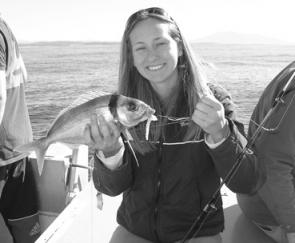The estuaries are heating up and other forms of fishing are also good around Bermagui this month.
As the land temperatures increase, so does the water in the estuaries, especially in the upper reaches. These are the areas to target, whether you prefer lures or bait.
After their Winter spawning, black bream are looking to put on condition and are feeding energetically over the flats, around oyster clumps and shallow weed beds. Anglers should pay a lot of attention to these areas and use polarised sunglasses to sight-fish these areas. Other likely species are whiting, trevally, flathead, blackfish and mullet, which can be caught on a wide range of lures and bait. The best baits are fresh yabbies (nippers) and prawns.
Further down the systems, blackfish numbers seem to be increasing with every tide. These fish are concentrated around rock walls, bridge and harbour pylons and are eating green and cabbage weed while nippers and worms also account for their share.
Large schools of tailor are gathering around the entrance to the harbour of an evening and small metal lures and floating pillies will produce fish. The rock platform near the entrance has seen some good fishing for drummer, blackfish and trevally, mostly on cabbage or cunjevoi.
The beaches have been consistent this year. Large schools of salmon are patrolling the coast and there are plenty of ways to target them. Lurefishing the beach is becoming more popular, mainly due to its simplicity. A handful of lures, a spin stick and a little trace material is all that’s required. Then find your beach, add water and have fun.
If you find fish throwing the hooks after taking the lure you can try one of three things. If you are using treble hooks, try offsetting the hooks by giving each hook a little twist with a pair of pliers. Also use two split rings joined together for a chain-like effect or go to a single hook like a Black Magic KS series. All these modifications will improve hook-ups.
Out on the reefs things are really heating up with nearly all the more popular areas producing. Good-sized blue and jackass morwong have been featuring prolifically with the larger fish coming from the deeper Twelve and Six Mile reefs.
Some good snapper are around and it’s definitely time for large, succulent tiger flathead. Tigers can be found just off the reef structure on the gravel and mud. Once they are encountered it is possible to obtain a bag without to much effort but if you find a good patch, don’t be surprised if they’re not in the same place next time. These fish tend to eat an area out and then move on.
I have noticed over many years some anglers leave a good catch of fish sitting in the bottom of a box with very little water over them and in direct sunlight. As you could imagine, by the end of a long fishing session these fish would not be at their optimum for the table.
A professional fisherman showed me years ago to have an esky with ice in it and then add saltwater to form a slurry. Place a fish in the slurry and it will chill to death quickly. Having returned to port, clean your fish and then wash and place them back in the slurry prior to preparing them for the table. This method will make ordinary fish taste better and it’s also a very quick way to cool the tinnies for the end of the day!
Gamefish have been up-and-down lately with nothing of significance captured. Some large mako sharks have been sighted around schools of striped tuna and I suspect if you were to put down a berley trail some action would occur.
One option is to fish the Twelve Mile Reef berleying for the sharks and, while you’re waiting, fish the bottom for some of those reef dwellers. Striped tuna, albacore and small yellowfin are providing some entertainment out wide for those trolling lures with the odd better yellowfin being encountered. Most productive lures are the small skirted variety with bibless diving lures taking the larger fish. These lures should always be used when tuna are about.
Spring has been early with birds nesting some time ago and the willow trees blooming earlier than normal. Speak to the older generation out west and when the willows gain their leaves, it’s time to fish for freshwater fish – and on the coast for bass. Brogo Dam is starting to perform reasonably with most fish being taken on the troll as water temps continue to rise.
In the river below the dam fish are moving back up after spawning and are feeding energetically, particularly on the warmer days.
no matter what your age.
Reads: 1154
Trevally in the shallows are great fun for young and old.

Jackass morwong from the deeper reefs are top tucker.

Don’t forget to use soft plastics in close for some surprising results like this goatfish.




